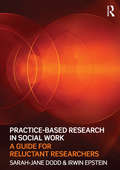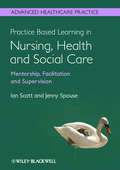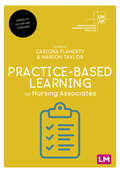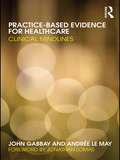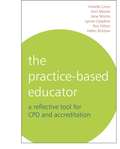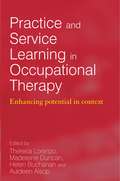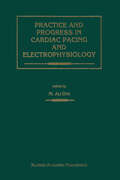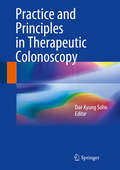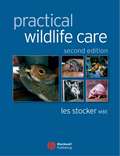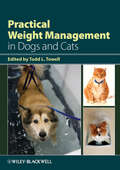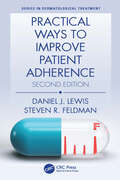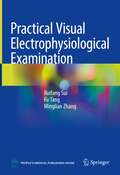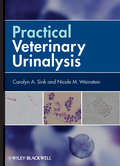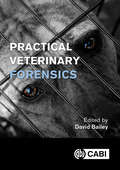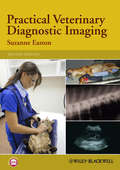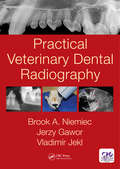- Table View
- List View
Practice-Based Research in Social Work: A Guide for Reluctant Researchers
by Sarah-Jane Dodd Irwin EpsteinThis unique textbook explores practice-based research (PBR), using numerous practice examples to actively encourage and engage students and practitioners to embrace research as a meaningful support for their practice. Whilst evidence-based practice gives practitioners access to information about "universal" best practices, it does not prioritize practitioner-generated knowledge or promote new research-based interventions relevant to their own practice circumstances as PBR does. This book discusses the evolution of PBR as a distinct social work research approach, describes its principles and methods and presents a range of exemplars illustrating the application of PBR within different practice methods in different practice settings. The chapters cover: Identifying the research question in a PBR model Designing a study and identifying a methodology Sampling Literature reviews Gathering data Ethics Analyzing data and interpreting results Putting research into practice Viewing the practitioner as central to the research process, and research as a necessary component of practice, this invaluable book emphasizes the seamless integration of practice and research. It is about research in social work practice rather than research on social work practice. Each chapter includes an overview, an introduction, and a key concepts summary. Practice-Based Research in Social Work is a very accessible text suitable for social work students, particularly MSW students, and practitioners.
Practice Based Learning in Nursing, Health and Social Care: Mentorship, Facilitation and Supervision
by Ian Scott Jenny SpouseWork-based learning facilitation, mentoring and coaching are all integral to the healthcare professions. Practice Based Learning in Nursing, Health and Social Care promotes effective professional learning in the workplace and helps healthcare professionals to develop, enhance, reflect on and change their practice and perceptions of mentoring, facilitating, and supervision. Aimed at the health and social care practitioner who is involved in facilitating learning, teaching and assessing learners in practice, this essential, comprehensive text explores several key themes, including: - The nature of facilitating (coaching, supervision, mentoring) within professional contexts - Learning in communities of practice - Becoming an effective facilitator/mentor - Understand and supporting work-based learning - Managing the unusual, such as failing learners or those with special needs - Giving and documenting feedback - Managing workloads in busy environments - Professional development issues Special features: A clear, accessible guide for new and experienced practice educators/facilitators alike A comprehensive, applied text for practitioners of all levels of experience in facilitation and supervision Written by authors with extensive experience in the field Uniquely focuses on the professional development of the mentor/facilitator themselves Provides case studies throughout showing illustrating common issues and how to engage in formal theories of professional practice Multiprofessional focus - aimed at all health and social care practitioners
Practice Based Learning in Nursing, Health and Social Care: Mentorship, Facilitation And Supervision (Advanced Healthcare Practice Ser.)
by Ian Scott Jenny SpouseWork-based learning facilitation, mentoring and coaching are all integral to the healthcare professions. Practice Based Learning in Nursing, Health and Social Care promotes effective professional learning in the workplace and helps healthcare professionals to develop, enhance, reflect on and change their practice and perceptions of mentoring, facilitating, and supervision. Aimed at the health and social care practitioner who is involved in facilitating learning, teaching and assessing learners in practice, this essential, comprehensive text explores several key themes, including: - The nature of facilitating (coaching, supervision, mentoring) within professional contexts - Learning in communities of practice - Becoming an effective facilitator/mentor - Understand and supporting work-based learning - Managing the unusual, such as failing learners or those with special needs - Giving and documenting feedback - Managing workloads in busy environments - Professional development issues Special features: A clear, accessible guide for new and experienced practice educators/facilitators alike A comprehensive, applied text for practitioners of all levels of experience in facilitation and supervision Written by authors with extensive experience in the field Uniquely focuses on the professional development of the mentor/facilitator themselves Provides case studies throughout showing illustrating common issues and how to engage in formal theories of professional practice Multiprofessional focus - aimed at all health and social care practitioners
Practice-Based Learning for Nursing Associates (Understanding Nursing Associate Practice)
by Cariona Flaherty Marion TaylorThis book will help you to prepare for and excel in your nursing associate practice placements. Covering all settings and all fields of nursing, the book will show you how to make the most of each placement and transfer learning and skills from one area of practice to another. Key features: - Fully mapped to the NMC Standards of Proficiency for Nursing Associates (2018) - Helps you prepare for placements in a way that best supports your professional development and personal wellbeing - Case studies and activities introduce you to different settings across all fields of nursing - Focussed specifically on the requirements of the nursing associate role, helping you to develop into a confident professional practitioner THE SERIES: The Understanding Nursing Associate Practice series (UNAP) is a new collection of books uniquely designed to support trainee nursing associates throughout their training and into a professional career.
Practice-Based Learning for Nursing Associates (Understanding Nursing Associate Practice)
by Cariona Flaherty Marion TaylorThis book will help you to prepare for and excel in your nursing associate practice placements. Covering all settings and all fields of nursing, the book will show you how to make the most of each placement and transfer learning and skills from one area of practice to another. Key features: - Fully mapped to the NMC Standards of Proficiency for Nursing Associates (2018) - Helps you prepare for placements in a way that best supports your professional development and personal wellbeing - Case studies and activities introduce you to different settings across all fields of nursing - Focussed specifically on the requirements of the nursing associate role, helping you to develop into a confident professional practitioner THE SERIES: The Understanding Nursing Associate Practice series (UNAP) is a new collection of books uniquely designed to support trainee nursing associates throughout their training and into a professional career.
Practice-Based Learning for Nursing Associates (Understanding Nursing Associate Practice)
This book will help you to prepare for and excel in your nursing associate practice placements. Covering all settings and all fields of nursing, the book will show you how to make the most of each placement and transfer learning and skills from one area of practice to another. Key features: - Fully mapped to the NMC Standards of Proficiency for Nursing Associates (2018) - Helps you prepare for placements in a way that best supports your professional development and personal wellbeing - Case studies and activities introduce you to different settings across all fields of nursing - Focussed specifically on the requirements of the nursing associate role, helping you to develop into a confident professional practitioner THE SERIES: The Understanding Nursing Associate Practice series (UNAP) is a new collection of books uniquely designed to support trainee nursing associates throughout their training and into a professional career.
Practice-based Evidence for Healthcare: Clinical Mindlines
by John Gabbay Andrée le MayThis book challenges the evidence-based practice movement to re-think its assumptions. Firmly rooted in real practice while drawing lucidly on a great breadth of theoretical frameworks, it examines afresh how clinicians use knowledge. Evidence-based practice has recently become a key part of the training of all health professionals. Yet despite its ‘gold-standard’ status, it is faltering because too much effort has gone into insisting on an idealised model of how clinicians ought to use the best evidence, while not enough has been done to understand why they so often don’t. Practice-based Evidence for Healthcare is a groundbreaking attempt to redress that imbalance. Examining how clinicians actually develop and use clinical knowledge day-to-day, the authors conclude that they use ‘mindlines’– internalised, collectively reinforced, tacit guidelines. Mindlines embody the composite and flexible knowledge that clinicians need in practice. They are built up during training and continually updated from a wide range of formal and informal sources. Before new evidence becomes part of practitioners’ mindlines, it is transformed by their interactions with colleagues and patients via their communities of practice and networks of trusted colleagues. To explore how mindlines work Gabbay and le May draw on a wide range of disciplines to analyse their detailed observations of clinical practice in the UK and the US. Their conclusions and provocative recommendations will be of value to all practitioners, health service managers, policymakers, researchers, educators and students involved in the promotion of evidence-based practice.
Practice-based Evidence for Healthcare: Clinical Mindlines
by John Gabbay Andrée le MayThis book challenges the evidence-based practice movement to re-think its assumptions. Firmly rooted in real practice while drawing lucidly on a great breadth of theoretical frameworks, it examines afresh how clinicians use knowledge. Evidence-based practice has recently become a key part of the training of all health professionals. Yet despite its ‘gold-standard’ status, it is faltering because too much effort has gone into insisting on an idealised model of how clinicians ought to use the best evidence, while not enough has been done to understand why they so often don’t. Practice-based Evidence for Healthcare is a groundbreaking attempt to redress that imbalance. Examining how clinicians actually develop and use clinical knowledge day-to-day, the authors conclude that they use ‘mindlines’– internalised, collectively reinforced, tacit guidelines. Mindlines embody the composite and flexible knowledge that clinicians need in practice. They are built up during training and continually updated from a wide range of formal and informal sources. Before new evidence becomes part of practitioners’ mindlines, it is transformed by their interactions with colleagues and patients via their communities of practice and networks of trusted colleagues. To explore how mindlines work Gabbay and le May draw on a wide range of disciplines to analyse their detailed observations of clinical practice in the UK and the US. Their conclusions and provocative recommendations will be of value to all practitioners, health service managers, policymakers, researchers, educators and students involved in the promotion of evidence-based practice.
The Practice-Based Educator: A Reflective Tool for CPD and Accreditation
by Vinette Cross Lynne Caladine Jane Morris Ros Hilton Helen Bristow Ann MooreDesigned for all those involved in education within the practice-based setting, this book encourages the reader to become involved in their own personal development as a practice-based educator through reflection on their own practice. The reader is encouraged to generate and organise evidence of their own Continuing Professional Development (CPD) through practice-based learning and teaching activities. The text is user-friendly and includes sections on the context of practice-based education, the role of the practice-based educator, facilitating learning in a practice-based setting, and assessing and evaluating practice-based learning. The authors are all educators of experience who have for many years been involved in practice-based education Fully updated to cover current trends such as the move to community-based practice and inter-professional practice Practical features include activities, reflective assignments and literature references
Practice and Service Learning in Occupational Therapy: Enhancing Potential in Context
by Theresa Lorenzo Madeleine Duncan Helen Buchanan Auldeen AlsopWhile this book is based primarily on experiences of occupational therapy practice education in South Africa, it aims to have international appeal as key principles of practice and service learning are drawn from the differing scenarios covered. Based on qualitative research, some of the book’s chapters describe issues faced by students in complex practice situations and highlight educational strategies for promoting socially responsive professional development. They show how students engage with the personal and professional challenges of working in a multicultural society and how situated learning can enhance their resourcefulness in meeting the needs of individuals, groups and communities. The book is divided into three sections: The first, on the practice education agenda, establishes the academic rationale for various forms of practice learning within an occupational therapy curriculum. The second section examines the learning opportunities offered by different practice contexts and highlights mechanisms for developing the professional identity of students. The final section, on enhancing potential, reviews mechanisms that may be used for supporting students in the field, and ends with a look at the future of practice education and how it might develop in response to social and international drivers.
Practice and Progress in Cardiac Pacing and Electrophysiology (Developments in Cardiovascular Medicine #183)
by M. Ali OtoDevelopments in the electrical treatment of arrhythmias have been so fast over the last few years that access to available, state-of-the-art knowledge has become a major challenge. The proceedings of scientific meetings are therefore most helpful in this regard. This volume provides highlights of many of the recent and most important technological advances and concepts in cardiac electrotherapy, written by the most prominent figures in the field, for the internists, clinical cardiologists and cardiologists who are practising in arrhythmias and antiarrhythmic therapy. The book is divided into five parts, each focusing on an exciting group of topics. Part One is a highlight of some of the hit points in arrhythmology. Part Two is a quick reference to the current concepts in non-invasive electrocardiology. Part Three, cardiac pacing, is enhanced by the introductory chapter of S. Furman, which gives the state-of-the-art in electrical cardiac stimulation for 1995. This part also reviews the technical advances, new perspectives in the indications of cardiac pacing, as well as the management of complications. Radiofrequency ablation as a challenging antiarrhythmic therapeutic strategy is thoroughly reviewed and the hottest topics are highlighted in Part Four. Part Five is dedicated to implantable cardioverter-defibrillators with several exciting topics, including driving with implantable devices.
Practice and Principles in Therapeutic Colonoscopy
by Dae Kyung SohnThis book presents state of the art knowledge and guidance on the use of therapeutic colonoscopy for all of the usual indications, including hemostasis for colorectal bleeding, resection of benign and malignant lesions, and decompression and recanalization of obstructed bowel. Technical aspects are covered in detail, with advice on indications and instrumentation and provision of tips and tricks of proven practical value. With respect to polypectomy, separate chapters focus on technique for pedunculated polyps and the choice between endoscopic piecemeal mucosal resection and endoscopic submucosal dissection for large sessile polyps. The closing chapter looks to the future of therapeutic colonoscopy. The clearly written text is supported by numerous helpful illustrations. Over the years, technological developments have markedly increased the therapeutic, as opposed to the diagnostic, role of endoscopy. This book will be an invaluable aid in clinical practice for all who are involved in the performance of therapeutic colonoscopy.
Practical Wildlife Care
by Les StockerWildlife care and rehabilitation is often on a one-to-one basis and involves a lot of time, care and skill. However, for many years, care of injured wildlife was regarded as a low priority and euthanasia was the recommended option. A lot has changed over the past twenty years and now caring for wildlife casualties is part of everyday life in many veterinary practices. Following on from the major success of the first edition, this second edition provides even more useful information on wildlife care and rehabilitation. As well as covering a whole range of species, with sections on birds, mammals, reptiles and amphibians, this edition now includes information on many ‘alien’ species appearing in the British countryside such as wallabies, wild boar and exotic reptiles. In this edition: Essential guidance on handling, first aid, feeding and releasing, and many other disciplines not featured in veterinary or nursing training Full of helpful tips from an expert in wildlife rehabilitation who has unparalleled practical experience Expanded chapters on the care of all species – particularly casualty badgers, otters and hedgehogs – and more comprehensive guidance on rearing orphaned mammals and birds Lots more colour pictures to aid in management and care techniques and the latest information on zoonotic diseases from around the world
Practical Wildlife Care
by Les StockerWildlife care and rehabilitation is often on a one-to-one basis and involves a lot of time, care and skill. However, for many years, care of injured wildlife was regarded as a low priority and euthanasia was the recommended option. A lot has changed over the past twenty years and now caring for wildlife casualties is part of everyday life in many veterinary practices. Following on from the major success of the first edition, this second edition provides even more useful information on wildlife care and rehabilitation. As well as covering a whole range of species, with sections on birds, mammals, reptiles and amphibians, this edition now includes information on many ‘alien’ species appearing in the British countryside such as wallabies, wild boar and exotic reptiles. In this edition: Essential guidance on handling, first aid, feeding and releasing, and many other disciplines not featured in veterinary or nursing training Full of helpful tips from an expert in wildlife rehabilitation who has unparalleled practical experience Expanded chapters on the care of all species – particularly casualty badgers, otters and hedgehogs – and more comprehensive guidance on rearing orphaned mammals and birds Lots more colour pictures to aid in management and care techniques and the latest information on zoonotic diseases from around the world
Practical Weight Management in Dogs and Cats
by Todd L. TowellPractical Weight Management in Dogs and Cats is a comprehensive, clinical reference for the veterinary health team, providing the necessary tools to successfully manage pet obesity. Bringing together specialists in nutrition, internal medicine, critical care, and surgery and rehabilitation, the book provides an overview of prevention techniques, clinical management, and practical tips for implementing successful programs and educating owners. Covering topics ranging from taking a nutritional history and body condition scoring to calculating food dosage and client communication tips, this book is a resource for both veterinarians and veterinary technicians to address the growing problem of pet obesity. The book begins by explaining the clinical importance of obesity, then moves on to diagnosing and preventing obesity. The heart of the book is devoted to managing body weight, with chapters on nutritional, pharmacotherapeutic, and exercise strategies, and two unique chapters cover owner compliance and wellness programs. Practical Weight Management in Dogs and Cats offers a collaborative approach to managing weight in pet dogs and cats.
Practical Weight Management in Dogs and Cats
by Todd L. TowellPractical Weight Management in Dogs and Cats is a comprehensive, clinical reference for the veterinary health team, providing the necessary tools to successfully manage pet obesity. Bringing together specialists in nutrition, internal medicine, critical care, and surgery and rehabilitation, the book provides an overview of prevention techniques, clinical management, and practical tips for implementing successful programs and educating owners. Covering topics ranging from taking a nutritional history and body condition scoring to calculating food dosage and client communication tips, this book is a resource for both veterinarians and veterinary technicians to address the growing problem of pet obesity. The book begins by explaining the clinical importance of obesity, then moves on to diagnosing and preventing obesity. The heart of the book is devoted to managing body weight, with chapters on nutritional, pharmacotherapeutic, and exercise strategies, and two unique chapters cover owner compliance and wellness programs. Practical Weight Management in Dogs and Cats offers a collaborative approach to managing weight in pet dogs and cats.
Practical Ways to Improve Patient Adherence (Series in Dermatological Treatment)
by Daniel J Lewis Steven R FeldmanThe New York Times has called adherence the world’s "other drug problem." Physicians prescribe medications, but patients do not always use them. While it would be easy for physicians to blame patients for treatment failures, physicians can do more to motivate patients to use their medications as recommended. Practical Ways to Improve Patient Adherence, Second Edition, is an excellent resource for physicians and allied health professionals whose patients exhibit poor adherence. Daniel J. Lewis, MD (Department of Dermatology, University of Pennsylvania Health System), and experienced adherence researcher, Steven R. Feldman, MD, PhD (Departments of Dermatology and Social Sciences & Health Policy, Wake Forest University School of Medicine), examine the problem of poor adherence and offer concrete techniques to encourage patients to use their medications and improve treatment outcomes. This book offers novel, potent ways to get patients to use their medications and improve treatment outcomes – tools healthcare providers can use day in and day out. A medical education is not complete without a thorough understanding of the hurdles that contribute to poor adherence and what health professionals can and should do about it."20 years of patient adherence research presented in a simple, fun, and easy-to-read style … a once-in-a-lifetime treat!" Warren H. Chan, MD, MS, Dermatologist"East to digest and remarkably practical for physicians. … Recommend it to all my friends in medicine!" Diego R. Dasilva, MD, Dermatologist Named the winner of the 2022 “Best Overall” Dermie Award by the Dermasphere podcast.Published in association with the Journal of Dermatological Treatment.
Practical Ways to Improve Patient Adherence (Series in Dermatological Treatment)
by Daniel J Lewis Steven R FeldmanThe New York Times has called adherence the world’s "other drug problem." Physicians prescribe medications, but patients do not always use them. While it would be easy for physicians to blame patients for treatment failures, physicians can do more to motivate patients to use their medications as recommended. Practical Ways to Improve Patient Adherence, Second Edition, is an excellent resource for physicians and allied health professionals whose patients exhibit poor adherence. Daniel J. Lewis, MD (Department of Dermatology, University of Pennsylvania Health System), and experienced adherence researcher, Steven R. Feldman, MD, PhD (Departments of Dermatology and Social Sciences & Health Policy, Wake Forest University School of Medicine), examine the problem of poor adherence and offer concrete techniques to encourage patients to use their medications and improve treatment outcomes. This book offers novel, potent ways to get patients to use their medications and improve treatment outcomes – tools healthcare providers can use day in and day out. A medical education is not complete without a thorough understanding of the hurdles that contribute to poor adherence and what health professionals can and should do about it."20 years of patient adherence research presented in a simple, fun, and easy-to-read style … a once-in-a-lifetime treat!" Warren H. Chan, MD, MS, Dermatologist"East to digest and remarkably practical for physicians. … Recommend it to all my friends in medicine!" Diego R. Dasilva, MD, Dermatologist Named the winner of the 2022 “Best Overall” Dermie Award by the Dermasphere podcast.Published in association with the Journal of Dermatological Treatment.
Practical Visual Electrophysiological Examination
by Ruifang Sui Fu Tang Minglian ZhangThis book includes the concept, general summary and the equipment of the visual electrophysiological examination. It also covers the clinical application scope, diagnosis protocol, standardized operation steps, clinical report samples, and the key points of reading reports, etc. of visual evoked potential (VEP), electroretinogram (ERG), electrooculogram (EOG), multifocal VEP, multifocal ERG and other commonly used visual electrophysiological examinations. Typical clinical report examples of normal and abnormal waveforms are specially added, which is a highlight of this book and can help clinical technicians quickly grasp the key points of electrophysiological report reading.
Practical Veterinary Urinalysis
by Carolyn A. Sink Nicole M. WeinsteinPractical Veterinary Urinalysis is a comprehensive, clinically relevant resource for the veterinary laboratory. This bench-top guide covers sample handling guidelines, interpretation of dry chemical analysis, and recommendations for physical and microscopic evaluation. Emphasizing diagnostic techniques and result interpretation, Practical Veterinary Urinalysis is an ideal aid for anyone who performs and interprets urinalysis testing. Beginning with an overview of renal physiology and urine production, the main focus of the book is examination and analysis of urine samples, including physical properties, chemical analysis, and sediment examination. Additional chapters review diagnostic tests and considerations for proteinuria, advanced diagnostics, quality assurance and laboratory set-up. Practical Veterinary Urinalysis is an invaluable tool for achieving accurate and reliable laboratory results and is a useful addition to any veterinary library.
Practical Veterinary Urinalysis
by Carolyn A. Sink Nicole M. WeinsteinPractical Veterinary Urinalysis is a comprehensive, clinically relevant resource for the veterinary laboratory. This bench-top guide covers sample handling guidelines, interpretation of dry chemical analysis, and recommendations for physical and microscopic evaluation. Emphasizing diagnostic techniques and result interpretation, Practical Veterinary Urinalysis is an ideal aid for anyone who performs and interprets urinalysis testing. Beginning with an overview of renal physiology and urine production, the main focus of the book is examination and analysis of urine samples, including physical properties, chemical analysis, and sediment examination. Additional chapters review diagnostic tests and considerations for proteinuria, advanced diagnostics, quality assurance and laboratory set-up. Practical Veterinary Urinalysis is an invaluable tool for achieving accurate and reliable laboratory results and is a useful addition to any veterinary library.
Practical Veterinary Forensics
by Karl Harrison Steven White Mr Lloyd Reeve-Johnson Claire Gwinnet Rachel Bolton King Nikolaos Kolatzis Dr Ernest Rogers Dr Deborah Rook Dr Claire Gwinnett Dr Rachel Bolton-King Dr Johan Schulze Dr Jenny Hamilton-Ible Dr Lucy Leicester Dr Louise MacLeod Dr Adele Wharton Dr Pippa SwanVeterinarians often come into contact with the law in cases of animal cruelty, domestic animal and wildlife crimes, and human crimes with an animal element. This book provides practical information and training on how to operate within a crime scene. It covers the tests that may need to be carried out, collecting evidence, preparing reports and giving evidence in court as an expert witness. Concentrating on the basic principles and background knowledge needed, the book includes hair, blood and bite mark analysis as well as an overview of firearms injury. It explores wider concepts such as the human-animal bond and one health, going on to give practical guidance and numerous case studies, which bring the book to life and into the real world of the busy crime scene. Practical Veterinary Forensics is an indispensable guide to all veterinarians working in cases of animal cruelty, abuse and crimes against animals. It is essential for welfare organizations, animal shelters and those requiring an introduction to veterinary forensic science.
Practical Veterinary Diagnostic Imaging
by Suzanne EastonPractical Veterinary Diagnostic Imaging is an essential and practical guide to the various diagnostic imaging modalities that are used in veterinary practice. It moves from basic mathematic and physical principles through to discussion of equipment and practical methods. Radiographic techniques for both small and large animals are covered. There is a separate chapter devoted to ultrasound, as well as discussion of advanced imaging techniques such as fluoroscopy, computerised tomography and magnetic resonance imaging. The book also covers legislation and safety issues in the context of their impact on the veterinary practice. Presented with clear line diagrams and photographs, Practical Veterinary Diagnostic Imaging also provides revision points and self-assessment questions in each chapter to aid study. It is an ideal guide for student and qualified veterinary nurses. It is also a useful reference for veterinary students and veterinarians in general practice who want a basic guide to radiography and other imaging modalities. KEY FEATURES Everything you need to know about diagnostic imaging in veterinary practice in a language you can easily understand The basic principles of physics presented in simple terms Improves your positioning techniques with practical tips for best practice Clear guidance on the use of digital imaging to improve image quality and reduce radiation doses to patients Companion website with additional resources (available at www.wiley.com/go/easton/diagnosticimaging)
Practical Veterinary Diagnostic Imaging
by Suzanne EastonPractical Veterinary Diagnostic Imaging is an essential and practical guide to the various diagnostic imaging modalities that are used in veterinary practice. It moves from basic mathematic and physical principles through to discussion of equipment and practical methods. Radiographic techniques for both small and large animals are covered. There is a separate chapter devoted to ultrasound, as well as discussion of advanced imaging techniques such as fluoroscopy, computerised tomography and magnetic resonance imaging. The book also covers legislation and safety issues in the context of their impact on the veterinary practice. Presented with clear line diagrams and photographs, Practical Veterinary Diagnostic Imaging also provides revision points and self-assessment questions in each chapter to aid study. It is an ideal guide for student and qualified veterinary nurses. It is also a useful reference for veterinary students and veterinarians in general practice who want a basic guide to radiography and other imaging modalities. KEY FEATURES Everything you need to know about diagnostic imaging in veterinary practice in a language you can easily understand The basic principles of physics presented in simple terms Improves your positioning techniques with practical tips for best practice Clear guidance on the use of digital imaging to improve image quality and reduce radiation doses to patients Companion website with additional resources (available at www.wiley.com/go/easton/diagnosticimaging)
Practical Veterinary Dental Radiography
by Brook A. Niemiec Jerzy Gawor Vladimír JeklWith over 1,000 clear, high-quality images, this in-depth full guide covers all aspects of veterinary dental radiography. Chapters explain the indications for – and importance of – this key area of veterinary practice, the equipment used, the essential techniques in developing and processing the radiograph, common errors made, and the pathology of the teeth. The book also explores radiographic interpretation in seven detailed sections, discussing all aspects from normal radiographic anatomy to endodontic disease and trauma. An additional chapter covers techniques and interpretation with exotics in three sections: rabbits, ferrets and rodents. The book concludes with a look at future directions in this field. Essential reading for all veterinary practitioners, this book is also the ideal guide for trainees.
